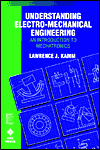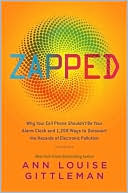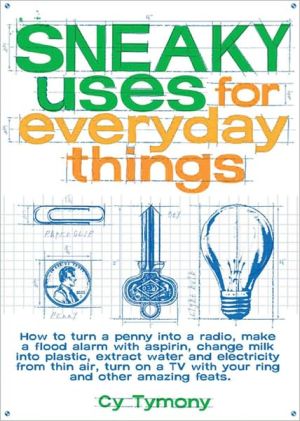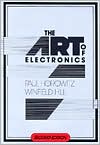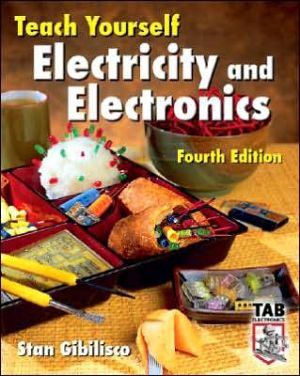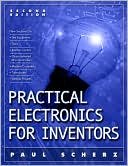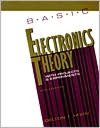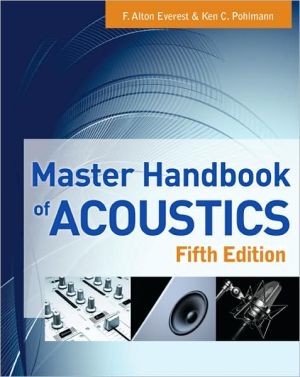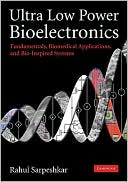Understanding Electro-Mechanical Engineering: An Introduction to Mechatronics
With a focus on electromechanical systems in a variety of fields, this accessible introductory text brings you coverage of the full range of electrical mechanical devices used today. You'll gain a comprehensive understanding of the design process and get valuable insights into good design practice. UNDERSTANDING ELECTROMECHANICAL ENGINEERING will be of interest to anyone in need of a non-technical, interdisciplinary introduction to the thriving field of mechatronics.
Search in google:
With a focus on electromechanical systems in a variety of fields, this accessible introductory text brings you coverage of the full range of electrical mechanical devices used today. You'll gain a comprehensive understanding of the design process and get valuable insights into good design practice. UNDERSTANDING ELECTROMECHANICAL ENGINEERING will be of interest to anyone in need of a non-technical, interdisciplinary introduction to the thriving field of mechatronics.
Understanding Electro-Mechanical Engineering\ An Introduction to Mechatronics \ \ By Lawrence J. Kamm \ John Wiley & Sons\ ISBN: 0-7803-1031-4 \ \ \ Chapter One\ Electrical Engineering\ 1.1 ELECTRICAL CONDUCTION\ 1.1.1 Solids\ Electricity is conducted by some solids, including metals and carbon. Their resistivity is independent of current density or direction but is dependent on temperature.\ Metal conductors are used in magnetizing coils, capacitor plates, resistors and heaters and as contacts, conductors, arc quenchers, mechanisms, and structures. Examples include contactors and circuit breakers [Chapter 9], [A9]. Magnetic metals are discussed below. In some relays, magnetic metals carry both magnetic flux and electric current.\ Some solids are superconducting at cryogenic temperatures; that is, their resistivity is truly zero, so there is no heating from conducted current. Some recently developed ceramics are superconducting at higher temperatures and show promise for economical devices. This effect is extremely useful for electro-magnet coils carrying high current densities to generate intense magnetic fields. An example is the levitation systems in experimental high-speed trains, which, of course, are large EMDs.\ Some solids are non-linear conductors in a variety of ways. The most important are doped semiconductors, such as silicon and germanium, used in transistors, diodes, light-emitting diodes (LEDs), photodiodes, and solid-state lasers. All these are used in EMDs. Silicon wafers are made into one-piece strain gauges and accelerometers. The conductors are built onto the surface and the entire disc serves as a diaphragm or proof mass, respectively. Silicon wafers are etched into parts for microminiature motors. Doped silicon is light sensitive and is the base of most photovoltaic cells.\ Selenium is a semiconductor whose resistivity is sensitive to light and to current direction. In the xerography process, a uniform electro-static charge is deposited on the selenium surface of a rotating drum; an image is imposed, either by optical projection or by laser scanning; the charge is conducted away where light reaches the surface; powdered ink (toner) is applied to the surface and adheres to the remaining charged areas; the surface is pressed against paper and the ink is transferred; finally, heat melts the ink to form a permanent image [Chapter 11]. Xerography is used in photoprinters, computer laser printers, and some computer plotters. Selenium has also long been used in photoelectric cells and in rectifiers.\ The resistivity of solids varies with temperature; in most metals, it increases almost linearly with absolute temperature. This is the basis for resistance thermometer temperature transducers, which measure temperature by measuring resistance [A18], [Chapter 7]. A few materials, such as carbon, have resistivities that decrease with increased temperature.\ The volume of solids, liquids, and gases (at constant pressure) increases with temperature. This effect is used in a variety of devices including bimetal elements and other temperature-sensitive devices [Chapter 7].\ Mechanical tensile and compressive stresses change the resistance of metal conductors. This effect has been of extreme value as the basis of the EM strain gauge [Chapter 7].\ Carbon has unique properties of great value in EMDs. It does not melt, evaporate, or weld under ordinary conditions; thus it is valuable for electrodes and contacts. It is chemically almost inert except for oxidizing at high temperatures, and its oxides are gases that blow away, so its surface remains uncontaminated. (Once oxidized, carbon becomes the basic element of all organic compounds, of course.) [Chapters 3, 4, and 9],\ Mercury is unique in being a metal that is liquid at room temperature; it melts at - 39°C. Mercury has enabled the construction of contact makers that would otherwise not be possible [Chapter 9].\ Properties of materials are tabulated in the handbooks listed in the References and Bibliography Group [B].\ 1.1.2 Liquids\ Liquid conductors include molten metals such as mercury, aluminum, and iron. Mercury is particularly useful in switching devices in which liquid mercury is made to flow instead of solid objects being made to move. Silent wall switches in the home are a common example [Chapter 9].\ Molten iron is agitated by induced eddy currents during steelmaking.\ Molten bauxite (aluminum oxide aluminum ore) conducts electricity during the electrolytic extraction of aluminum.\ Another large class of liquid conductors is ionized solutions, such as salt water, in which conduction is by physical motion of the electrolyte's ions. In electrolytic conduction, the H+ ions release hydrogen gas at the negative electrode. The gas may coat that electrode with fine bubbles that obstruct current flow; this effect is called polarization. Positive ions of metal may deposit as a metal film on the negative electrode; this is electroplating.\ 1.1.3 Gases\ Ionized gases conduct electricity, with positive ions moving one way and free negative electrons moving the other way. This is what happens in neon signs, fluorescent lamps, and certain lasers. An ionized gas is called a plasma. Evaporated mercury is a gas much used as an electrical conductor, for example in fluorescent lamps.\ In a sense, vacuum is a superconductor since it allows electrons to move through it with no voltage drop other than that used to accelerate the electrons. This occurs in television and other cathode-ray tubes and in other vacuum tubes. The motion of the electrons is accelerated by electric and magnetic fields and obeys the same Newtonian laws as do the motion of baseballs. (Gravity fields also accelerate the electrons but the effect is negligible in practical electron devices.) When electron speed approaches the speed of light, relativistic effects also occur.\ In mass spectrographs, ions move through a vacuum, electro-statically accelerated and magnetically deflected. (Is a mass spectrograph a kind of curvilinear motor and therefore an EMD? If it is, so is every cathode-ray and other vacuum tube! Does it matter? "A rose by any other name would smell as sweet.")\ Conduction in metals is by free electrons moving in the metal; conduction in an electrolyte is by ions moving in the solution; but conduction in a vacuum requires a separate source of electrons, such as a hot filament, or a separate source of ions.\ 1.1.4 Contacts Conductor surfaces that touch one another conduct electricity from one to the other, depending on the conditions of the surfaces; the principal obstacles are the oxide and dirt layers that may be on the surfaces. Silver, gold, platinum, palladium, and rhodium-are called noble metals because they resist chemical attack such as oxidation in air. Therefore, they make good contact materials in switching devices even though their resistivities (other than silver's), and costs, are higher than those of copper or aluminum alloys [Chapter 9],\ Carbon is also noble (although not usually called so), but its resistivity is high and it is difficult to make a low-resistance connection to it. (One way is to electro-plate the carbon with tin and then solder to the tin surface.) Carbon has the useful property that the resistance between carbon parts in contact with one another or with metal parts varies inversely with the force pressing the parts together. This is the basis for the following devices:\ The carbon granule microphone [Sections 7.4.1 and 12.2]\ A rheostat in which a stack of carbon plates is compressed by an adjusting screw\ A spot heater [Chapter 13]\ Carbon does not melt, so it cannot be welded, intentionally or otherwise, and its oxides are gases that dissipate. These properties make it a valuable contact material in relays and circuit breakers [Chapter 9].\ Silver is a special case. In air, it develops a sulfide coating (tarnish), but the coating is conductive. Since silver is cheap, it is a very common electrical contact material. A limitation of silver is its tendency to migrate over plastic surfaces and cause electrical leakage and short circuits.\ In many switching devices, the contact surfaces are made to rub against each other (wipe) when they are brought together to scrape away dirt and chemical contaminants. This is particularly important for inexpensive switches and connectors whose contact surfaces are bronze or other non-noble metals [Chapter 9].\ Many switching devices are enclosed in a vacuum or an inert gas to prevent atmospheric chemical or dirt contamination. Motion is transmitted to them via flexible diaphragms, bellows, magnetic fields, or gravity. Examples are reed switches, mercury switches, and vacuum circuit breakers [Chapter 9]. A vacuum or an inert gas also reduces arcing.\ A solid conductor in contact with a liquid or gas is called an electrode. (Welding, medical, and chemical electrodes may also contact solids.) There is little problem with inadequate conductivity, but there may be severe problems with corrosion. In some instruments, the electro-chemical voltage between electrode and liquid would cause errors, so platinum electrodes may be used. In batteries, of course, these electro-chemical voltages provide electric power.\ This electrolytic corrosion is sometimes combated by providing sacrificial electrodes, usually of zinc, which corrode, instead of the metal of the device to be protected, which is typically steel. Large devices, such as steel pipelines, are sometimes protected by electric voltages applied between the device and the earth. Even nominally dry contact between dissimilar metals can produce corroding voltages and currents if a return path exists. Corrosion of iron pipe in contact with copper tubing is a common example.\ Electrolytic removal and deposition of metal are not always bad; this is the basis of electro-plating and electro-polishing and of a technique of metal purification. The original ampere-hour meter electro-plated silver from an anode to a cathode; weighing the electrodes gave an accurate measure of ampere-seconds, or coulombs. Another useful device is a running time meter comprising a small, sealed, glass tube with electrodes at each end and with a slug of metal at one electrode. A fixed current is sent through the device whenever the associated equipment is on. Transfer of metal to the other electrode is read on a scale calibrated in hours.\ 1.2 ELECTRICAL INSULATION\ Insulation is as important as conduction; you must not only get electricity from here to there, but you must also prevent it from leaking out and spreading to where you do not want it.\ The important electrical properties of insulating materials are dielectric strength, dielectric constant, dielectric loss, and arc and tracking resistance. For circuit breaker arc quenching, high thermal capacitance is of great value; hydrogen and sulfur hexafluoride are of particular value, as are solids that outgas (ablate) when heated by an arc [Chapter 9].\ Dielectric loss is useful when it allows heating insulating material with high-frequency electric fields.\ Insulating materials include solids, liquids, and gases. Most organic and inorganic compounds and non-metallic elements are insulators.\ 1.2.1 Solids\ Many solid insulating materials are plastic laminates; and many others are polymers or mixtures, such as molding compounds with and without fillers. Coils are sometimes molded into solid plastic insulators, usually after being outgassed in a vacuum to allow the uncured plastic to penetrate the windings. Voids in electrical assemblies are sometimes filled with liquid potting compounds that harden in place. Solid insulation is fabricated by molding, machining, and laminating.\ Organic solid insulators include molded thermoplastic and thermoset plastics, laminated plastic, wood, paper, cloth, and fiber.\ Inorganic solid insulators include glasses, ceramics, mica, and glass filled with mica particles. Silicones are organic or inorganic, depending on one's chemistry semantics. They resemble organic compounds in many ways and make excellent insulation, particularly in place of other organics at high temperatures.\ The important non-electrical properties of solid insulating materials are strength, stiffness, creep, brittleness, temperature resistance, moisture, chemical and fungus resistance, toxicity, fabrication properties, and aesthetic attractiveness [Group B].\ 1.2.2 Liquids\ Liquid insulating materials are used to immerse and impregnate many transformers, capacitors, high-voltage cables, and high-voltage switches.\ Long after they started to be used as insulators or manufacturing solvents, it was discovered that some materials were carcinogens, were poisons, damaged the ozone layer, or otherwise polluted the environment. Most of these materials were liquids, such as polychlorinated biphenyls (PCBs) and chlorofluorocarbons (CFCs), that spread easily or were volatile. Asbestos, a solid, was long used as an excellent heat-resistant insulation before it was discovered to be a carcinogen. (The fine strands of asbestos float through the air and hook into lung tissue.) [Chapter 27].\ 1.2.3 Gases\ Gases, usually under pressure, are used instead of air as insulating materials in some devices such as large circuit breakers and high-voltage cables. Sulfur hexafluoride is a particularly good insulator. Hydrogen is an excellent electrical insulator and heat conductor, but it is a dangerous explosive.\ Vacuum is an excellent insulator provided there is no source of either free electrons, such as a hot filament, or of ions; both can pass freely through it.\ The properties of insulating materials are tabulated in the handbooks in [Group B],\ 1.3 ELECTRO-MAGNETISM\ 1.3.1 Magnetism\ Many electro-magnetic devices are EMDs, but since the word electromagnetic occurs in this book less frequently than electro-mechanical, it is spelled out each time. Alphabet soup is not a worthy end in itself.\ A magnetic field is produced by every electric current. In most electromagnetic devices, a current flows through a coil of many turns, N, the field of each turn adding to the fields of the other turns. The total magnetizing effect of a coil, magnetomotive force, (MMF), is measured as ampere turns, NI.\ Magnetic material atoms have what amounts to electric currents in superconducting short-circuited rings. These may be thought of as aligned electron spins and orbits, although a physicist would call this description a rough approximation of quantum mechanical phenomena. In both soft magnetic materials, such as pure iron, and hard (permanent) magnetic materials, such as Alnico, MMF is required to change the directions of atom alignments from random to parallel and from parallel alignments in one direction to parallel alignments in the opposite direction. (It is as if there were friction among the atoms). The tendency for the alignments to remain in the same direction until forced to change by an MMF is called hysteresis. The difference between soft and hard (permanent) magnetic materials is the difference between low and high hysteresis. This difference is many orders of magnitude beween the least and the greatest.\ Most materials have no effect on magnetic fields, which pass right through them, but some materials provide easier paths than air, that is, they have permeability greater than air. Principal among these are iron and nickel and their alloys. Parts made of these materials reduce the ampere turns necessary to produce a desired magnetic field. As moveable parts, they help convert electrical energy to mechanical work, as described later.\ These ferromagnetic materials saturate at some level of magnetic field density. Therefore, they are not helpful for fields much above saturation density. Some iron-nickel alloys have very high permeability and very low hysteresis but saturate at a low magnetic field density. These alloys are useful in sensitive relays, certain transformers, and sensors for weak fields.\ Some materials, such as bismuth, have permeability slightly less than that of air. They are diamagnetic; iron is paramagnetic or ferromagnetic.\ (Continues...)\ \ \ \ \ Excerpted from Understanding Electro-Mechanical Engineering by Lawrence J. Kamm Excerpted by permission.\ All rights reserved. No part of this excerpt may be reproduced or reprinted without permission in writing from the publisher.\ Excerpts are provided by Dial-A-Book Inc. solely for the personal use of visitors to this web site. \ \
List of IllustrationsPrefaceAbout the AuthorIntroduction1Ch. 1Electrical Engineering9Ch. 2Mechanical Engineering35Ch. 3Generators and Motors67Ch. 4Brakes and Clutches88Ch. 5Amplifiers101Ch. 6Actuators111Ch. 7Transducers128Ch. 8Controlled Motion153Ch. 9Contact Makers and Electrodes172Ch. 10Computer Components202Ch. 11Marking Paper212Ch. 12Sound222Ch. 13Manufacturing229Ch. 14Assembling and Connecting239Ch. 15Military Devices254Ch. 16Medical Devices257Ch. 17Consumer Devices263Ch. 18Passive Electrical Components268Ch. 19The Science and the Art275Ch. 20How One Designs278Ch. 21Minimum Constraint Design284Ch. 22Design for Manufacturing289Ch. 23User-Friendly Design294Ch. 24Accuracy, Adjustment, and Gauging297Ch. 25Reliability, Defects, Abuse, Failure, and Maintenance300Ch. 26Barriers, Filters, Conduits, and Valves309Ch. 27Ecology320Ch. 28Money324Ch. 29Cost Reduction and Product Improvement327Ch. 30Constraints on Design334Ch. 31People Engineering337Ch. 32Getting Help345Ch. 33Design Parameters349Ch. 34Product Classes and Families352Appendix: Patent Classification357References and Bibliography361Index371
